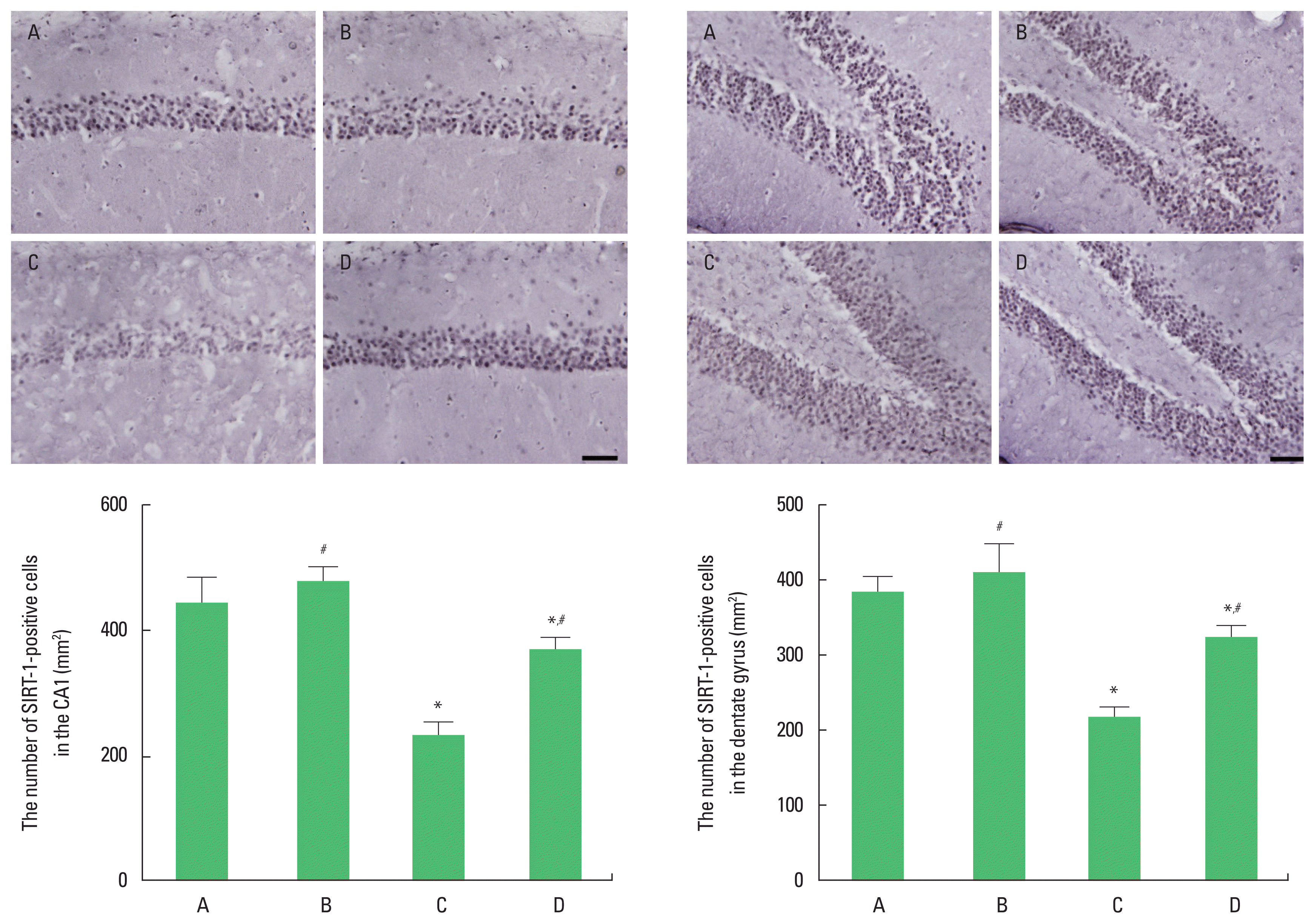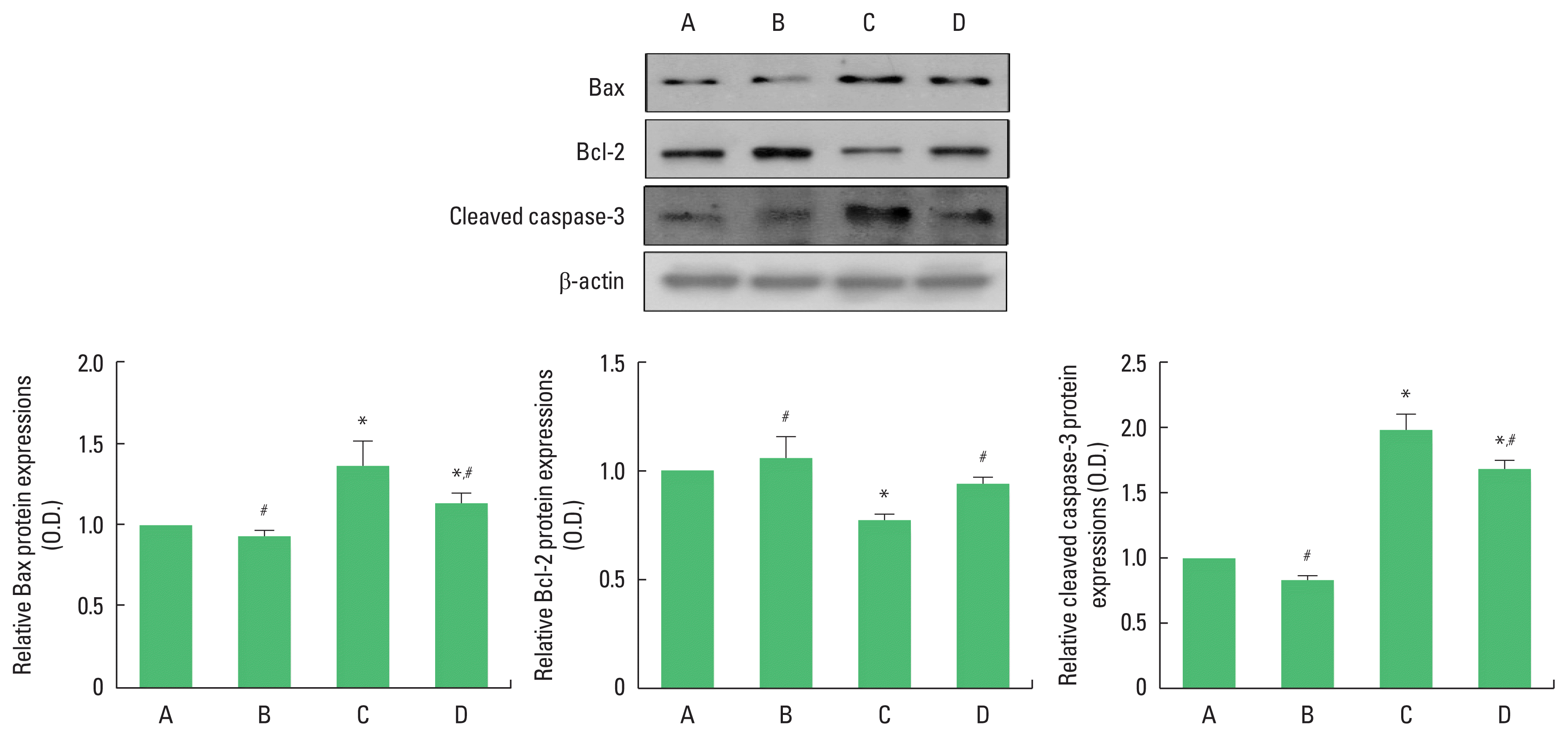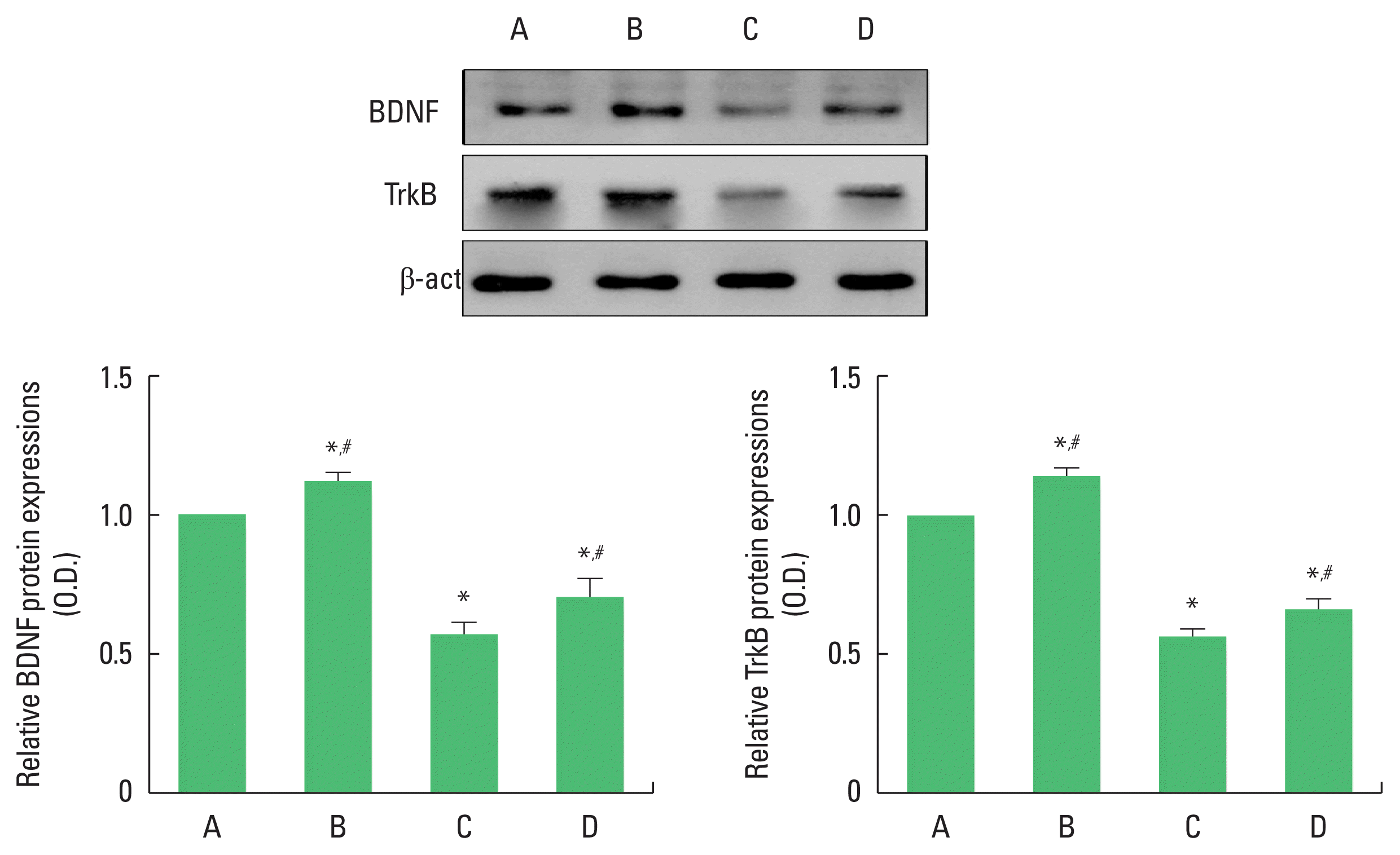Treadmill exercise ameliorates social isolation-induced memory impairment by enhancing silent information regulator-1 expression in rats
Article information
Abstract
The effect of treadmill exercise on the social isolation-induced memory impairment in relation with the silent information regulator-1 (SIRT-1) was investigated. The rats in the control groups lived four in the stan-dard cages for 8 weeks. The rats in the social isolation groups lived alone in the small cages for 8 weeks. The rats in the treadmill exercise groups were subjected to run on a treadmill for 30 min once a day for 8 weeks. We used step-through avoidance test for short-term memory and Morris water maze task for spatial working memory. Immunohisto-chemistry for SIRT-1 and western blot analysis for Bax, Bcl-2, cleaved caspase-3, brain-derived neurotrophic factor (BDNF), and tropomyosin receptor kinase B (TrkB) were performed. The rats in the social isolation group showed a decrease in short-term memory and spatial working memory. Treadmill exercise alleviated short-term memory and spatial working memory in the social isolation rats. SIRT-1 expression in the hippocampus was decreased in the rats of social isolation group. Treadmill exercise increased SIRT-1 expression in the social isolation rats. Bax expression was increased, Bcl-2 expression was decreased, and cleaved caspase-3 expression in the hippocampus was increased in the rats of social isolation group. Treadmill exercise decreased Bax expression, increased Bcl-2 expression, and decreased cleaved caspase-3 expression in the social isolation rats. Hippocampal BDNF and TrkB expression was decreased in the rats of social isolation group. Treadmill exercise increased BDNF and TrkB expression in the social isolation rats.
INTRODUCTION
Social isolation is a one-dimensional concept that can be defined as a lack of social integration (Hawton et al., 2011). Long-term social isolation causes stress, anxiety, and depression, leading to cognitive impairment and serious morbidity (Chida et al., 2006). Rodents have been widely used to assess developmental change in the fear and stress-related behaviors, and can exhibit a number of behavioral changes including anxiety response, decreased cognitive function, decreased motor activity, and aggressive behavior (Hefner and Holmes, 2007). During adolescence, the rats in the social isolation showed anxiety, depression, and short-term memory impairment, while swimming exercise relieved anxiety, depression, and short-term disability (Park et al., 2020).
Silent information regulator-1 (SIRT-1) is a deacetylating enzyme that is affected by nicotinamide adenine dinucleotide (NAD), reflecting changes in the energy levels of cells. It is effective in retarding aging and is especially important for the management of biological tissue homeostasis. SIRT-1 is involved in the development and regulation of various processes such as cell growth, apoptosis, and repair of DNA damage (Lalla and Donmez, 2013). Calorie restriction and exercise were used to activate SIRT-1, and activation of SIRT-1 delayed cell aging and provided a neuroprotective effect (Ramis et al., 2015). Exercise increased the level of NAD and activated the NAD-dependent deacetylase activity of SIRT-1.
Apoptosis is a form of cell death that serves to remove dying cells from cell proliferating or differentiating, thus apoptosis plays an important role in normal development and tissue homeostasis. However, inappropriate or excessive apoptosis is associated with neurological disorders (Lee et al., 2003). Bcl-2 family is classified into anti-apoptotic proteins and pro-apoptotic proteins according by function. Bcl-2, an antiapoptotic protein, is known to regulate apoptotic pathways and protect against cell death. Bax, a pro-apoptotic protein of that family, is expressed abundantly and selectively during apoptosis and promotes cell death (Song et al., 2018). Activation of caspases is another important characteristic of apoptosis, and caspase-3 is a main performer of apoptosis (Song et al., 2018).
Hippocampal brain-derived neurotrophic factor (BDNF) is known to be increased by learning and exercise (Hall et al., 2000; Park et al., 2019). Exercise-induced BDNF expression increases neurogenesis and enhances long-term potentiation of the hippocampus (Farmer et al., 2004). Exercise has been reported to improve neurological disorders caused by various types of brain damages. Treadmill exercise increased expression of BDNF and tropomyosin receptor kinase B (TrkB) (Park et al., 2019).
Many hippocampal neurons were significantly increased in the exercised rats, suggesting that regular aerobic exercise exerted beneficial effect on cognitive function (Uysal et al., 2005). Relationship between exercise and SIRT-1 activation under social isolation condition has not been well established. In this study, we investigated the effect of treadmill exercise on social isolation-memory impairment in relation with SIRT-1.
MATERIALS AND METHODS
Experiment animals
This study was approved by the Kyung Hee University Institutional Animal Care and Use Committee in Seoul, Korea (KHUASP [SE]-16-154). Male Wistar rats (48 weeks old) were used for this experiment. Rats were randomly divided into four groups (n=8 per group): control group, control and exercise group, social isolation group, social isolation, and exercise group.
Social isolation protocol
Social isolation was conducted by previously described method (Amiri et al., 2015). The rats in the control groups lived four in the standard cages (26 cm×42 cm×18 cm) for 8 weeks. The rats in the social isolation groups lived alone in the small cages (20 cm× 26 cm×13 cm) for 8 weeks.
Exercise protocol
The rats in the treadmill exercise groups were subjected to run on a treadmill for 30 min once a day for 8 weeks. Exercise load consisted of warm-up at a speed of 3 m/min for the first 5 min, at a speed of 8 m/min for last 25 min, with the 0° inclination.
Step-through avoidance test
Step-through avoidance test was performed. The rats were placed on a 7×25-cm platform with a height of 2.5 cm, and then allowed to rest on platform for 2 min. Platform faced a 42×25-cm grid of parallel 0.1-cm caliber steel bars, which were spaced 1 cm apart. In training session, the rats received a 1-mA scramble foot shock for 2 sec immediately upon stepping down. Latency time (second) in each group was measured at 2 hr after training session. Latency over 300 sec was counted as 300 sec.
Morris water maze task
Morris water maze task was performed. Training test consisted of three trials each day for 6 consecutive days. During each trial, the rats were placed in water facing the wall of maze in one of three quadrants that did not contain platform. Probe trial was performed at 24 hr after the end of the 6 days of training. Percentage of time spent in the target quadrant was considered as an indicator of memory performance.
Tissue preparation
The animals were sacrificed immediately after determination of Morris water maze task. The animals were fully anesthetized Zoletil 50 (10 mg/kg, intraperitoneally; Vibac Laboratories, Carros, France). The rats were transcardially perfused with 50 mM phosphate-buffered saline and then fixed with freshly prepared solution of 4% paraformaldehyde in 100 mM phosphate buffer (pH, 7.4). Brains were then removed, postfixed in same fixative overnight, and transferred into a 30% sucrose solution. Coronal sections with thicknesses of 40 μm were made using a freezing microtome (Leica, Nussloch, Germany).
Immunohistochemistry for SIRT-1
To visualize SIRT-1 expression, immunohistochemistry for SIRT-1 in the hippocampal CA1 and dentate gyrus was performed. Sections were selected from each brain and incubated overnight with human anti-SIRT-1 antibody (1:200; Santa Cruz Biotechnology, Santa Cruz, CA, USA), then with biotinylated mouse secondary antibody (1:200; Vector Laboratories, Burlingame, CA, USA) for another 1 hr 30 min. Secondary antibody was amplified with Vector Elite ABC kit (1:100; Vector Laboratories). Antibody-biotin-avidin-peroxidase complexes were visualized using 0.03% diaminobenzidine, and sections were mounted onto gelatin-coated slides. Slides were air-dried overnight at room temperature, and coverslips were mounted using Permount (Thermo Fisher Scientific, Waltham, MA, USA).
Western blotting for BDNF, TrkB, Bax, Bcl-2, and cleaved caspase-3
Hippocampus tissues were homogenized on ice and lysed in a lysis buffer containing 50 mM Tris–HCl (pH, 7.5), 150 mM NaCl, 0.5% deoxycholic acid, 1% Nonidet P40, 0.1% sodium dodecyl sulfate (SDS), 1 mM PMSF, and 100-mg/mL leupeptin. Protein content was measured using a Bio-Rad colorimetric protein assay kit (Bio-Rad, Hercules, CA, USA). Protein of 30 μg was separated on SDS-polyacrylamide gels and transferred onto a nitrocellulose membrane, which was incubated with mouse β-actin antibody (1:2,000; Santa Cruz Biotechnology), mouse Bcl-2 antibody (1:1,000; Santa Cruz Biotechnology), rabbit BDNF antibody (1:1,000; Santa Cruz Biotechnology), rabbit TrkB antibody (1:1,000; Cell Signaling Technology, Beverly, MA, USA), rabbit Bax antibody (1:1,000; Cell Signaling Technology) and rabbit cleaved caspase-3 antibody (1:1,000; Cell Signaling Technology). Horseradish peroxidase-conjugated anti-mouse for β-actin, Bcl-2, and anti-rabbit for BDNF, TrkB, Bax, cleaved caspase-3 were used as the secondary antibodies.
Data analysis
For confirming expression of BDNF, TrkB, Bax, Bcl-2, cleaved caspase-3, detected bands were calculated densitometrically using Molecular Analyst TM, version 1.4.1. Number of SIRT-1-positive cells in dentate gyrus was counted hemilaterally under a light microscope (Olympus, Tokyo, Japan). Data were analyzed with one-way analysis of variance and then Duncan post-hoc tests. All values are expressed as the mean±standard error of mean, and P-value <0.05 was considered significant.
RESULTS
Short-term memory and spatial working memory
We used step-through avoidance test for short-term memory and Morris water maze task for spatial working memory (Fig. 1). Latency of the social isolation group was shorted than the control group (P<0.05). Treadmill exercise lengthened latency in the rats of the social isolation group (P<0.05). Time in probe quadrant of the social isolation group was shorted than the control group (P<0.05). Treadmill exercise lengthened time in probe quadrant in the rats of the social isolation group (P<0.05).

The effects of treadmill exercise on the short-term memory in step-through test (left panel) and spatial working memory in Morris water maze task (right panel). A, control group; B, control and exercise group; C, social isolation group; D, social isolation and exercise group. The data are presented as the mean±standard error of the mean. *P<0.05 compared to the control group. #P<0.05 compared to the social isolation group.
SIRT-1-positive cells in hippocampus
Number of SIRT-1-positive cells in the hippocampus was counted (Fig. 2). Number of SIRT-1-positive cells in the hippocampal CA1 and dentate gyrus of the social isolation group was decreased than the control group (P<0.05). Treadmill exercise increased numbers of SIRT-1-positive cells in the rats of the social isolation group (P<0.05).

The effects of treadmill exercise on silent information regulator-1 (SIRT-1)-positive cells. Upper panel: immunohistochemistry of SIRT-1-positive cells in the hippocampal CA1 (left) and dentate gyrus (right). Lower panel: the number of SIRT-1-positive cells in the hippocampal CA 1 (left) and dentate gyrus (right). The scale bar represents 50 μm in each group. A, control group; B, control and exercise group; C, social isolation group; D, social isolation and exercise group. The data are presented as the mean±standard error of the mean. *P<0.05 compared to the control group. #P<0.05 compared to the social isolation group.
Bax, Bcl-2, and cleaved caspase-3 expression in the hippocampus
Expression of Bax, Bcl-2, and cleaved caspase-3 in the hippocampus was analyzed (Fig. 3). Expression of Bax and cleaved caspase-3 was increased (P<0.05) and expression of Bcl-2 was decreased in the rats of the social isolation group than the control group (P<0.05). Treadmill exercise decreased expression of Bax and cleaved caspase-3 (P<0.05) and increased expression of Bcl-2 in the rats of the social isolation group (P<0.05).

The effects of treadmill exercise on Bax, Bcl-2, and cleaved caspase-3 protein expression in the hippocampus. Upper panel: representative expression of Bax, Bcl-2, and cleaved caspase-3. Lower panel: relative expression of Bax (left), Bcl-2 (middle), and cleaved caspase-3 (right) in each group. A, control group; B, control and exercise group; C, social isolation group; D, social isolation and exercise group. The data are presented as the mean±standard error of the mean. *P<0.05 compared to the control group. #P<0.05 compared to the social isolation group.
BDNF and TrkB expression in the hippocampus
Expression of BDNF and TrkB was analyzed (Fig. 4). Expression of BDNF and TrkB was decreased in the rats of the social isolation group than the control group (P<0.05). Treadmill exercise increased expression of BDNF and TrkB in the rats of the social isolation group (P<0.05).

Effects of treadmill exercise on brain-derived neurotrophic factor (BDNF) and tyrosine kinase B (TrkB) expressions in the hippocampus. Upper panel: representative expression of BDNF and TrkB. Lower panel: relative expression of BDNF (left) and TrkB (right). A, Sham-operation group; B, sham-operation and treadmill exercise group; C, traumatic brain injury (TBI)-induced group; D, TBI-induced and treadmill exercise group. *P<0.05 compared to the sham-operation group. #P<0.05 compared to the TBI-induced group.
DISCUSSION
Novel object recognition and fear conditioning were significantly impaired in the social isolation mice (Võikar et al., 2005). Social isolation reduced neurogenesis in the hippocampal dentate gyrus and impaired spatial memory in rodents (Ibi et al., 2008). In this study, the rats in the social isolation group showed a decrease in short-term memory and spatial working memory compared to the control rats. In contrast, treadmill exercise alleviated short-term memory and spatial working memory in the social isolation rats.
SIRT-1 provides cellular stress resistance by inhibiting apoptosis transcription factor p53 and forkhead (Bordone and Guarente, 2005). In addition, SIRT-1 has been shown to mobilize fat by inhibiting peroxisome proliferative-activating receptor in white adipose tissue (Bordone and Guarente, 2005). Caloric restriction and exercise activate adenosine monophosphate-activated protein kinase, and then SIRT-1 is activated in many tissues (Ruderman et al., 2010). Aging inhibits specific activity of SIRT-1 in cerebellum, which interferes with motor function. (Marton et al., 2010). Regular exercise reduced detrimental effects of aging process through SIRT-1-dependent pathways (Koltai et al., 2010). Physical exercise improved mitochondrial function of brain cortex and cerebellum, and decreased oxidative stress and apoptosis-related markers (Marques-Aleixo et al., 2015). In this study, SIRT-1 expression in the hippocampus was decreased in the rats of the social isolation group compared to the control rats. In contrast, treadmill exercise increased SIRT-1 expression in the social isolation rats.
Social isolation and chronic unpredictable mild stress showed depressive behavior and exhibited mixed apoptosis/autophagy characteristics (Wang et al., 2019). Social isolation rats during adolescence showed increased in Bax expression and decreased in Bcl-2 expression compared to the group-housed rats (Park et al., 2020). In this study, Bax expression was increased, Bcl-2 expression was decreased, and cleaved caspase-3 expression in the hippocampus was increased in the rats of the social isolation group compared to the control rats. In contrast, treadmill exercise decreased Bax expression, increased Bcl-2 expression, and decreased cleaved caspase-3 expression in the social isolation rats.
Regular exercise improved cognitive function and affected brain neuroplasticity and neuronal growth (Radák et al., 2001). Exercise is a special form of stress in that it is predictable and spontaneous, and other forms of psychological and physiological stress are unpredictable, uncontrollable, and have a marked effect on behavior and synaptic plasticity (Wosiski-Kuhn and Stranahan, 2012). It is thought that increased expression of BDNF and TrkB influenced cognitive function by treadmill exercise in the social isolation group. Compared to the rats that received 2 per cage, isolated rats had a significantly reduced BDNF concentration in the hippocampus, while no change was observed in other brain regions examined such as prefrontal cortex and striatum (Scaccianoce et al., 2006). BDNF and TrkB expression in the hippocampus was suppressed in the social isolation rats (Park et al., 2020). In this study, hippocampal BDNF and TrkB expression were decreased in the rats of the social isolation group compared to the control rats. In contrast, treadmill exercise increased BDNF and TrkB expression in the social isolation rats.
Exercise activated SIRT-1, and then promoted learning and memory formation through BDNF-dependent manner (El Hayek et al., 2019). Exercise enhanced SIRT-1 expression, then suppressed apoptosis and enhanced BDNF expression, resulting in memory improvement. Therefore, exercise can be used as a therapeutic strategy to improve memory function that has been impaired by social isolation.
ACKNOWLEDGMENTS
This work was supported by the Ministry of Education of the Republic of Korea and National Research of Foundation of Korea (NRF-2017S1A5A2A01026488).
Notes
CONFLICT OF INTEREST
No potential conflict of interest relevant to this article was reported.